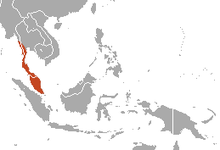Dusky leaf monkey
| Dusky leaf monkey[1] | |
|---|---|

| |
| Scientific classification | |
| Domain: | Eukaryota |
| Kingdom: | Animalia |
| Phylum: | Chordata |
| Class: | Mammalia |
| Order: | Primates |
| Suborder: | Haplorhini |
| Infraorder: | Simiiformes |
| Family: | Cercopithecidae |
| Genus: | Trachypithecus |
| Species: | T. obscurus
|
| Binomial name | |
| Trachypithecus obscurus (Reid, 1837)
| |

| |
| Dusky leaf monkey range | |
The dusky leaf monkey, spectacled langur, or spectacled leaf monkey (Trachypithecus obscurus) is a species of primate in the family Cercopithecidae. It is found in Malaysia and Thailand[3]
Habitation and activity patterns
The Trachypithecus obscurus are primate species that are found in the Peninsular region of Malaysia. Scan and sampling of 13 individuals (2 adult males, 8 adult females, 3 juveniles) was done by researchers from University Sains Malaysia. The researchers found that most of the dusky leaf monkeys spent their times positioning. The time that the dusky leaf monkey spent posting was estimated to be 40%. Researchers also found that the individuals spent approximately 33% of their time feeding on the leaves of the plants. In this research, researchers found these dusky leaf monkeys feeding on 10 different forest plant species on a regular basis. Dusky leaf monkeys tend to consume leaves which grow at higher elevations such as in the canopy level of a forest.[4]
There are several subspecies of this lutung:[1]
- Trachypithecus obscurus obscurus
- Trachypithecus obscurus flavicauda
- Trachypithecus obscurus halonifer
- Trachypithecus obscurus carbo
- Trachypithecus obscurus styx
- Trachypithecus obscurus seimundi
- Trachypithecus obscurus sanctorum

-
Dusky leaf monkey - Kaeng Krachan National Park
-
Lost dusky leaf monkey calling - Kaeng Krachan National Park.
-
Dusky leaf monkey - Kaeng Krachan National Park
-
Adult male spectacled langur
References
- ^ a b Groves, C. P. (2005). Wilson, D. E.; Reeder, D. M. (eds.). Mammal Species of the World: A Taxonomic and Geographic Reference (3rd ed.). Baltimore: Johns Hopkins University Press. p. 177. ISBN 0-801-88221-4. OCLC 62265494.
- ^ Boonratana, R.; Traeholt, C.; Brockelmann, W.; Htun, S. (2008). "Trachypithecus obscurus". The IUCN Red List of Threatened Species. 2008: e.T22039A9349397. doi:10.2305/IUCN.UK.2008.RLTS.T22039A9349397.en.
{{cite journal}}: Unknown parameter|last-author-amp=ignored (|name-list-style=suggested) (help) - ^ "Dusky Leaf Monkey". aboutanimals. Retrieved 30 May 2020.
{{cite web}}: CS1 maint: url-status (link) - ^ M, Siti-Kauthar & Faudzir, Najmuddin & Md zain, Badrul munir & M.A.B, Abdul-Latiff. (2019). PrimaTourism: Preliminary Study on Activity Budget of Dusky leaf monkey Trachypithecus obscurus obscurus in Bukit Soga Perdana, Batu Pahat, Johor. IOP Conference Series: Earth and Environmental Science. 269. 10.1088/1755-1315/269/1/012045.
- Yap, Joleen & Ruppert, Nadine & Fadzly, Nik. (2016). Activity patterns and diet of a group of wild dusky leaf monkeys (Trachypithecus obscurus) in Penang, Malaysia (2016).
External links
![]() Data related to Trachypithecus obscurus at Wikispecies
Data related to Trachypithecus obscurus at Wikispecies
![]() Media related to Trachypithecus obscurus at Wikimedia Commons
Media related to Trachypithecus obscurus at Wikimedia Commons
- Information on Dusky Leaf Monkeys from the Santa Barbara Zoo
- Information on Dusky Leaf Monkeys from Monkeyland Primate Sanctuary




